7 Great Underwater Photography Books
March 2000
By Stephen Frink
The Underwater Photographer
||
|---|
|

|
| Related Product: Buy "The Underwater Photographer" now|
(Second Edition) by Martin Edge. Focal Press, published 1999, ISBN 0-240-51581-1.
Written by talented photo educator Martin Edge, this well-illustrated 234-page softcover book is targeted to the more advanced underwater photographer. Martin's work may not be familiar to North Americans because he is from England and is most often published in the European dive press; however, a quick study of his images will confirm his qualifications to teach. His words will likewise convey significant insight into the underwater photographic process.
As Edge explains in the preface, "I have convinced myself that choosing a particular type of film, balancing the exposures, selecting a shutter speed and determining placement and distance of my flash gun were purely mechanical techniques that, given time, virtually anyone could master. I was forever searching for the 'essence' which separated the good technician from the great underwater photographers." While his book does in fact provide insights valuable to the technician with chapters on basic techniques and equipment, it more passionately speaks of a "TC System" (his acronym for "Think and Consider") as a means to successfully translate the vision of the mind's eye onto a frame of film.
To this end, Edge intellectualizes on topics such as subject selection, non-threatening approach, lighting, composition and previsualization. He gives valuable practical advice on how to capture (on film) the various subjects likely to be found along the tropical coral reef, including marine life, shipwrecks and divers as models. Blending strobe with ambient light, multiple strobe techniques, creative use of shutter speeds, and creating abstract images are all topics included in this compelling, valuable reference.
The Underwater Photography Handbook
||
|---|
|

|
| Related Product: Buy "The Underwater Photography Handbook" now|
by Annemarie and Danja Kohler. New Holland Publishers (UK) and Stackpole Books (U.S.), published 1998, ISBN 0-8117-2966-4.
This is a 160-page softcover text targeted both to underwater still photography and video. Personally, I have never been able to serve these dual masters, preferring to give my total concentration to still photography. The team orientation of this text permits Annemarie to expound on the basic principles of underwater video while Danja dedicates her attention to the techniques of still photography.
This is a considerably more basic text than Edge's book, covering entry-level topics like the obvious first decision, still or video, as well as the subsequent issues that evolve depending on which branch is taken. Still shooters get a nice introduction to choices between amphibious and housed systems; and how-to sections on equipment maintenance, camera controls, optimizing exposure, and photographic techniques for the primary subjects likely to be found along the reef (macro, reef dwellers and wide-angle scenics).
While a portion of the book is dedicated to more abstract topics like composition, I find this to be more of a technical reference. The photographs are quite nice in the categories of fish and macro, although the wide-angle illustrations could use some refinement. The graphics are instructive and artfully rendered, and the wealth of general information makes this a worthwhile addition to the underwater photographer's library.
Video enthusiasts likewise have a chapter on equipment, but given the speed at which changes occur in the video realm, anything written in 1998 will inevitably be slightly dated today. For example, super VHS-C, Hi-8 and digital video is discussed, but new technologies like the hybrid Digital 8mm are not. Fortunately, most of the information in the "how-to" chapters is more generic and provides a good, if basic, reference. Planning shots, video shooting techniques, thinking sequentially, and techniques of post-production and editing are all part of the video section of this book. Still shooters and videographers may both consider this handbook a useful primer for launching their underwater imaging obsession.
Jim Church's Essential Guide to Nikonos Systems & Jim Church's Essential Guide to Composition
||
|---|
|

|
| Related Products: Buy "Jim Church's Essential Guide to Nikonos Systems" now|
| Buy "Jim Church's Essential Guide to Composition" now|
Jim Church's Essential Guide to Nikonos Systems, by Jim Church, Aqua Quest Publications, published 1994, ISBN 1-881652-04-1
Jim Church's Essential Guide to Composition, by Jim Church, Aqua Quest Publications, published 1998, ISBN 1-881652-18-1
While these two are totally separate books, I like to think of them as companion volumes. Written by one of underwater photography's great educators, Jim Church, each book has the potential to take an aspiring underwater photographer to a new level.
With the Essential Guide to the Nikonos Systems, Jim explains everything anyone could ever want to know about how to use the Nikonos V and Nikonos RS systems. There is the obligatory information about how light is affected once it passes below the surface of the water, as well as lucid explanations of f-stops, depth of field and exposure considerations. The function of strobes is covered in general, and more specifically, how TTL should work. Both Nikonos V and Nikonos RS systems are covered in great detail, as well as more creative techniques like blending strobe and ambient light and close-focus-wide-angle compositions. The final chapter on camera maintenance is filled with good, well-illustrated advice on preventative care for your Nikonos systems. For any Nikonos shooter, this text is a must-have.
The Essential Guide to Composition is a deceptively valuable title. In some respects you either have a good sense of composition or you don't, and as a result many photo instructors don't teach composition at all. In Jim's words "I believe that some photographers, such as Chris Newbert and David Doubilet, have a natural eye for photo composition. The majority of us--including myself--don't have a natural eye. However, we can learn to improve our photography by studying basic techniques of composition. Whatever talent we have can be nurtured and developed with study and practice." This book seeks to explain, and thereby nurture, artistic composition in underwater photography.
Jim points out the elements that may attract a viewer's eye to a composition, and then suggests optical tools and techniques that might enhance successful compositions. Subject selection, working with dive models, light versus dark backgrounds, action anticipation and means to isolate your subject within a composition are all covered. Traditional compositional considerations such as the rule of thirds, triangles and pyramids, and left-to-right eye travel are all mentioned; but Jim goes beyond adherence to simple rules and suggests individual creativity. For some shooters, inspired composition is innate and instinctive. The other 99 percent of underwater photographers will find something educational in this text.
The Traveler's Guide to ER (Emergency Repair) for the Nikonos V Camera
||
|---|
|

|
|

|
| Related Product: Buy "The New Guide to Sea & Sea" now|
by Mike Haber and Mike Mesgleski, self-published 1998, contact Subtropix Productions at 305-251-1962 or fax 305-251-1962.
There are a massive number of Nikonos V cameras out there, and if my experience is any indication, at some point this camera may flood. Knowing what to do quickly in terms of field repairs makes all the difference between a flooded Nikonos V becoming a mild nuisance or an expensive repair.
This book will help anyone with a modest amount of mechanical aptitude recognize the signs of a flood, and then with simple text and photographic illustrations walk them through disassembly, rinsing, drying and reassembly. If you're thousands of miles from any repair facility and water ends up on the wrong side of your Nikonos V O-ring, you'll be glad to have Haber and Mesgleski in your travel kit.
The New Guide to Sea & Sea
by Joe Liburdi and Cara Sherman, Orca Publications, published 1997, ISBN 0-9621111-3-9
While there are several books to choose from to learn about Nikonos cameras or underwater photography in general, there is only one comprehensive guide dedicated to the ever-expanding Sea & Sea product line. Joe Liburdi and Cara Sherman's collaboration entitled The New Guide to Sea & Sea is a 335-page softcover compendium of charts, illustrations, text and photographs logically organized to present the a wealth of information on both technique and equipment. In addition, more advanced topics like composition, care and maintenance, troubleshooting, traveling and first-aid for floods are covered.
The photos are very well-executed, and chosen to illustrate specific points of text. However, there is a subliminal message as well, for they artfully demonstrate the quality and versatility of the various Sea & Sea systems used. While new Sea & Sea products have been introduced since this book was published, most notably the MX-5 camera and YS-90 and YS-350 strobes, this book is more about the art and science of underwater photography than it is about specific equipment. It is an absolute must for Sea & Sea shooters, but should also be considered a fine reference for any underwater photo enthusiast.
Coral Seas
by Roger Steene, Firefly Books (U.S.), published in 1998, ISBN 1-55209-290-9
Out of 272 pages, there is precious little detailed photographic information in this book. It is only in a few paragraphs on the last page that Roger Steene explains that the photos in the book were taken with a housed 35mm SLR and single flash mounted directly above the camera housing. He allows that his lens arsenal includes a 14mm, 20mm, 24mm, 28-70mm, 60mm macro, 105mm macro, and a few specialty items like a 2X teleconverter for the super-macros and a split diopter for the over/unders. His film of choice is 100 ISO slide film. There's nothing remarkable about the tools, yet there is plenty that is remarkable about the photography, both in terms of how he captured his subjects, and in many cases, how he even saw these creatures.
||
|---|
|

|
| Related Product: Buy "Coral Seas" now|
Clearly this book is not about the things underwater photographers so commonly obsess over--things like gear or film or technique. Instead, this book is all about one man's astounding vision, and his ability to document the bizarre beauty and grandeur of Indo-Pacific reefs.
The result of five years of intensive work in places like Indonesia, Papua New Guinea, the Solomon Islands, the Red Sea and the Great Barrier Reef, Steene's photos of the reef's minutiae are among the best ever published. To fully appreciate these images one must experience the boredom of lying motionless along a sand flat waiting for a garden eel to emerge from its burrow. Or struggle with choppy seas while trying to capture an over/under of a shallow coral garden. Or try to pick out a camouflaged pygmy seahorse no larger than a grain of rice from amid a mass of coral polyps. Only then will you realize these photographs are a triumph of patience, talent and countless hours beneath the sea.
The Underwater Photographer
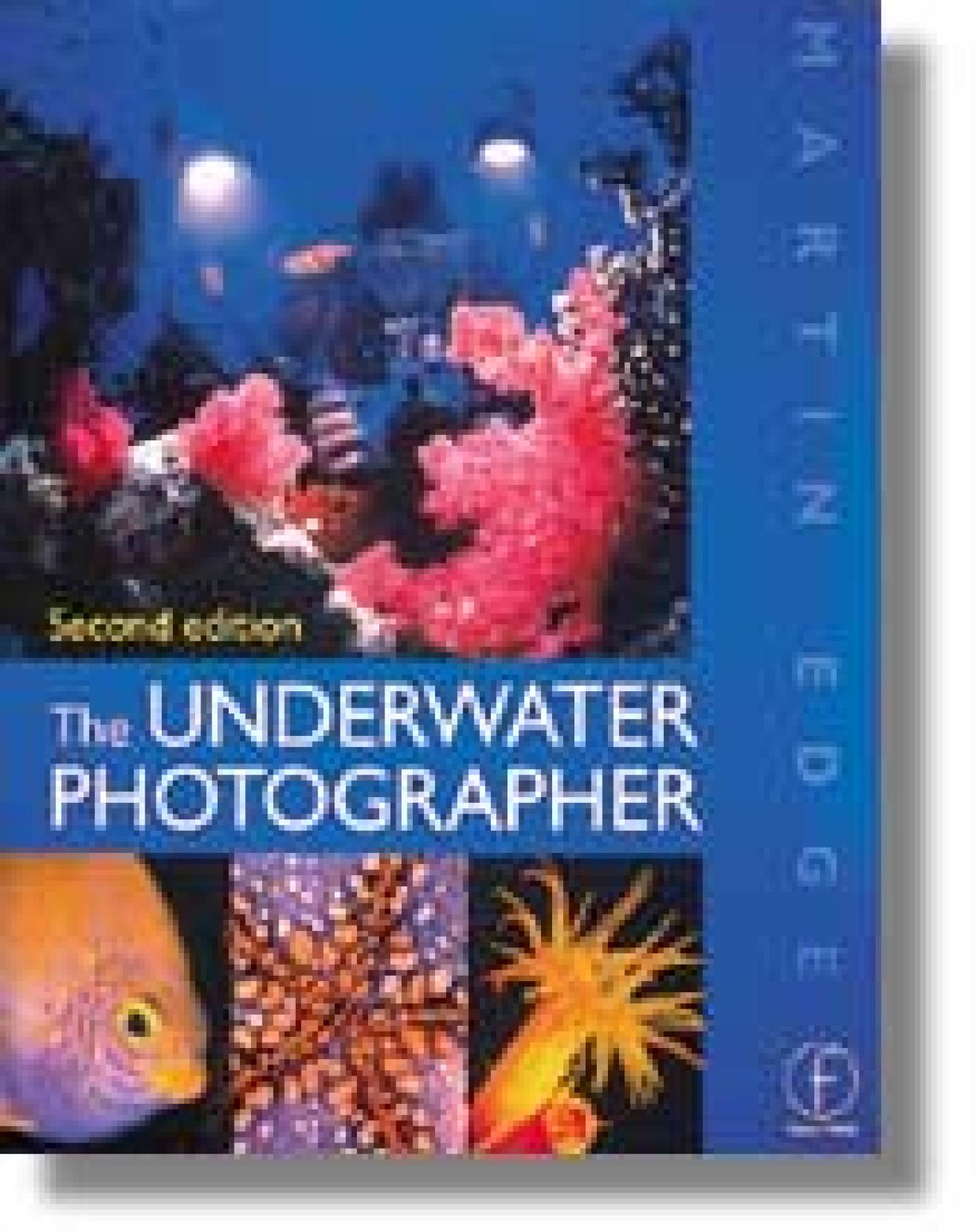
Related Product: Buy "The Underwater Photographer" now| (Second Edition) by Martin Edge. Focal Press, published 1999, ISBN 0-240-51581-1.
Written by talented photo educator Martin Edge, this well-illustrated 234-page softcover book is targeted to the more advanced underwater photographer. Martin's work may not be familiar to North Americans because he is from England and is most often published in the European dive press; however, a quick study of his images will confirm his qualifications to teach. His words will likewise convey significant insight into the underwater photographic process.
As Edge explains in the preface, "I have convinced myself that choosing a particular type of film, balancing the exposures, selecting a shutter speed and determining placement and distance of my flash gun were purely mechanical techniques that, given time, virtually anyone could master. I was forever searching for the 'essence' which separated the good technician from the great underwater photographers." While his book does in fact provide insights valuable to the technician with chapters on basic techniques and equipment, it more passionately speaks of a "TC System" (his acronym for "Think and Consider") as a means to successfully translate the vision of the mind's eye onto a frame of film.
To this end, Edge intellectualizes on topics such as subject selection, non-threatening approach, lighting, composition and previsualization. He gives valuable practical advice on how to capture (on film) the various subjects likely to be found along the tropical coral reef, including marine life, shipwrecks and divers as models. Blending strobe with ambient light, multiple strobe techniques, creative use of shutter speeds, and creating abstract images are all topics included in this compelling, valuable reference.
The Underwater Photography Handbook
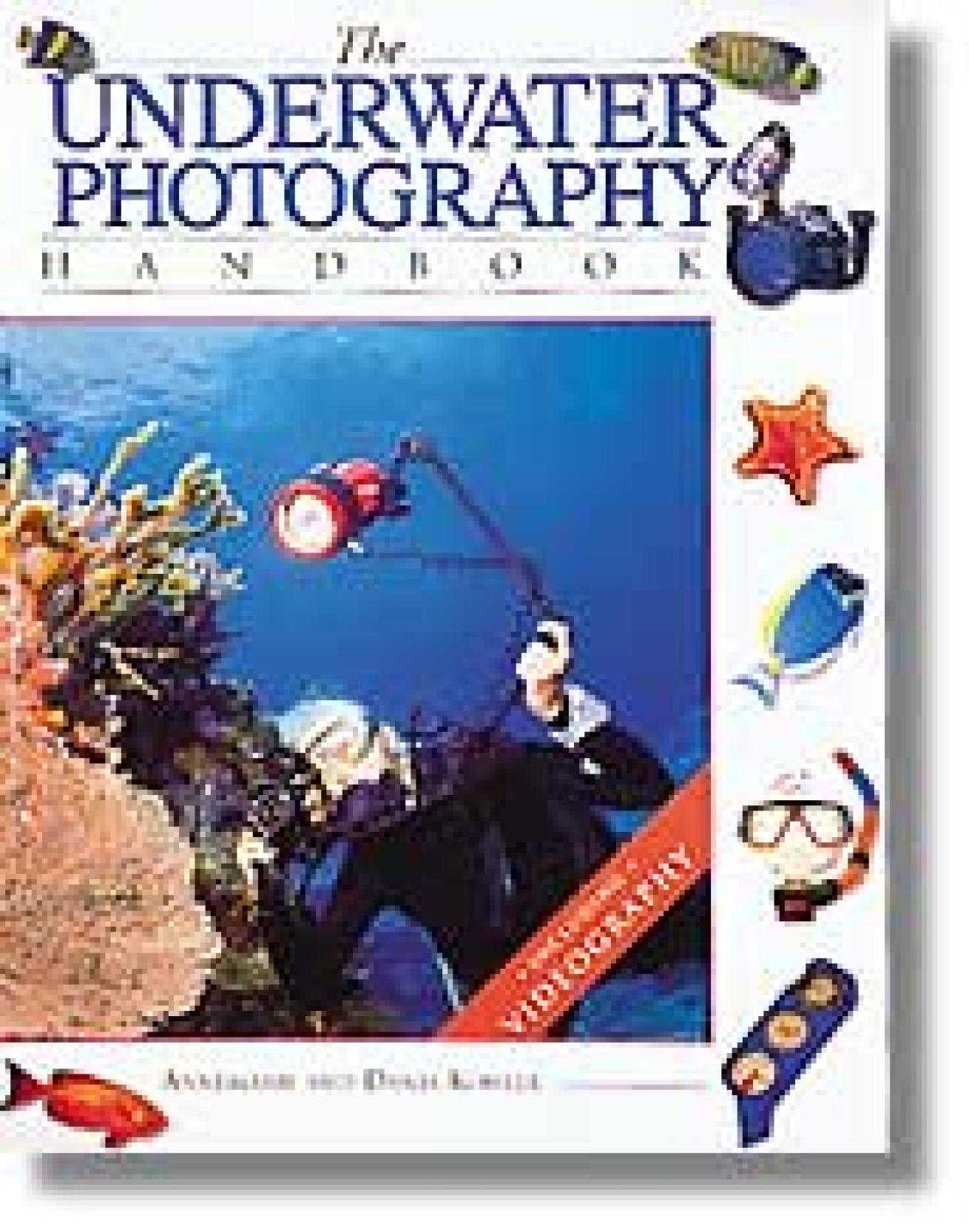
Related Product: Buy "The Underwater Photography Handbook" now| by Annemarie and Danja Kohler. New Holland Publishers (UK) and Stackpole Books (U.S.), published 1998, ISBN 0-8117-2966-4.
This is a 160-page softcover text targeted both to underwater still photography and video. Personally, I have never been able to serve these dual masters, preferring to give my total concentration to still photography. The team orientation of this text permits Annemarie to expound on the basic principles of underwater video while Danja dedicates her attention to the techniques of still photography.
This is a considerably more basic text than Edge's book, covering entry-level topics like the obvious first decision, still or video, as well as the subsequent issues that evolve depending on which branch is taken. Still shooters get a nice introduction to choices between amphibious and housed systems; and how-to sections on equipment maintenance, camera controls, optimizing exposure, and photographic techniques for the primary subjects likely to be found along the reef (macro, reef dwellers and wide-angle scenics).
While a portion of the book is dedicated to more abstract topics like composition, I find this to be more of a technical reference. The photographs are quite nice in the categories of fish and macro, although the wide-angle illustrations could use some refinement. The graphics are instructive and artfully rendered, and the wealth of general information makes this a worthwhile addition to the underwater photographer's library.
Video enthusiasts likewise have a chapter on equipment, but given the speed at which changes occur in the video realm, anything written in 1998 will inevitably be slightly dated today. For example, super VHS-C, Hi-8 and digital video is discussed, but new technologies like the hybrid Digital 8mm are not. Fortunately, most of the information in the "how-to" chapters is more generic and provides a good, if basic, reference. Planning shots, video shooting techniques, thinking sequentially, and techniques of post-production and editing are all part of the video section of this book. Still shooters and videographers may both consider this handbook a useful primer for launching their underwater imaging obsession.
Jim Church's Essential Guide to Nikonos Systems & Jim Church's Essential Guide to Composition
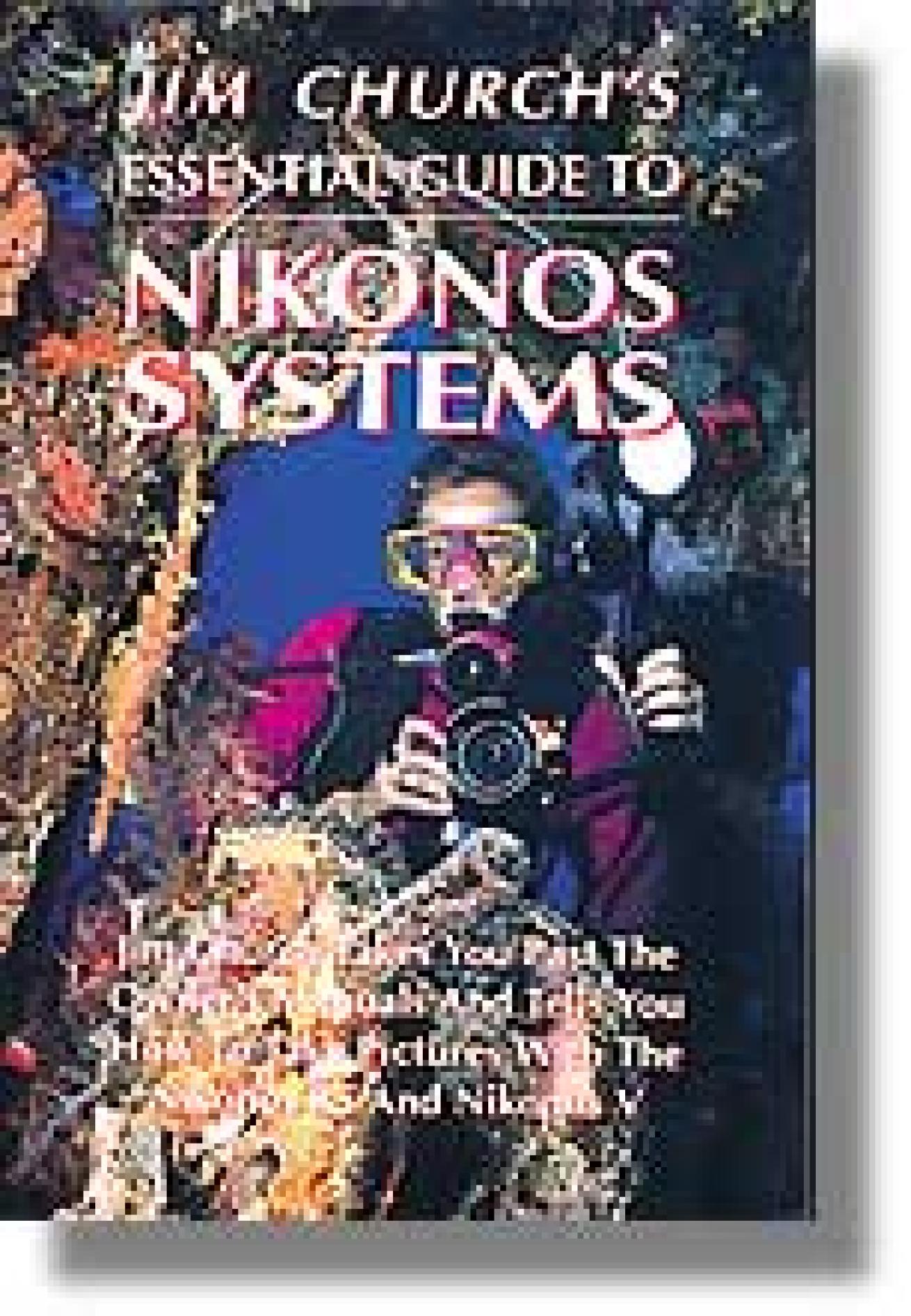
Related Products: Buy "Jim Church's Essential Guide to Nikonos Systems" now| | Buy "Jim Church's Essential Guide to Composition" now| Jim Church's Essential Guide to Nikonos Systems, by Jim Church, Aqua Quest Publications, published 1994, ISBN 1-881652-04-1
Jim Church's Essential Guide to Composition, by Jim Church, Aqua Quest Publications, published 1998, ISBN 1-881652-18-1
While these two are totally separate books, I like to think of them as companion volumes. Written by one of underwater photography's great educators, Jim Church, each book has the potential to take an aspiring underwater photographer to a new level.
With the Essential Guide to the Nikonos Systems, Jim explains everything anyone could ever want to know about how to use the Nikonos V and Nikonos RS systems. There is the obligatory information about how light is affected once it passes below the surface of the water, as well as lucid explanations of f-stops, depth of field and exposure considerations. The function of strobes is covered in general, and more specifically, how TTL should work. Both Nikonos V and Nikonos RS systems are covered in great detail, as well as more creative techniques like blending strobe and ambient light and close-focus-wide-angle compositions. The final chapter on camera maintenance is filled with good, well-illustrated advice on preventative care for your Nikonos systems. For any Nikonos shooter, this text is a must-have.
The Essential Guide to Composition is a deceptively valuable title. In some respects you either have a good sense of composition or you don't, and as a result many photo instructors don't teach composition at all. In Jim's words "I believe that some photographers, such as Chris Newbert and David Doubilet, have a natural eye for photo composition. The majority of us--including myself--don't have a natural eye. However, we can learn to improve our photography by studying basic techniques of composition. Whatever talent we have can be nurtured and developed with study and practice." This book seeks to explain, and thereby nurture, artistic composition in underwater photography.
Jim points out the elements that may attract a viewer's eye to a composition, and then suggests optical tools and techniques that might enhance successful compositions. Subject selection, working with dive models, light versus dark backgrounds, action anticipation and means to isolate your subject within a composition are all covered. Traditional compositional considerations such as the rule of thirds, triangles and pyramids, and left-to-right eye travel are all mentioned; but Jim goes beyond adherence to simple rules and suggests individual creativity. For some shooters, inspired composition is innate and instinctive. The other 99 percent of underwater photographers will find something educational in this text.
The Traveler's Guide to ER (Emergency Repair) for the Nikonos V Camera
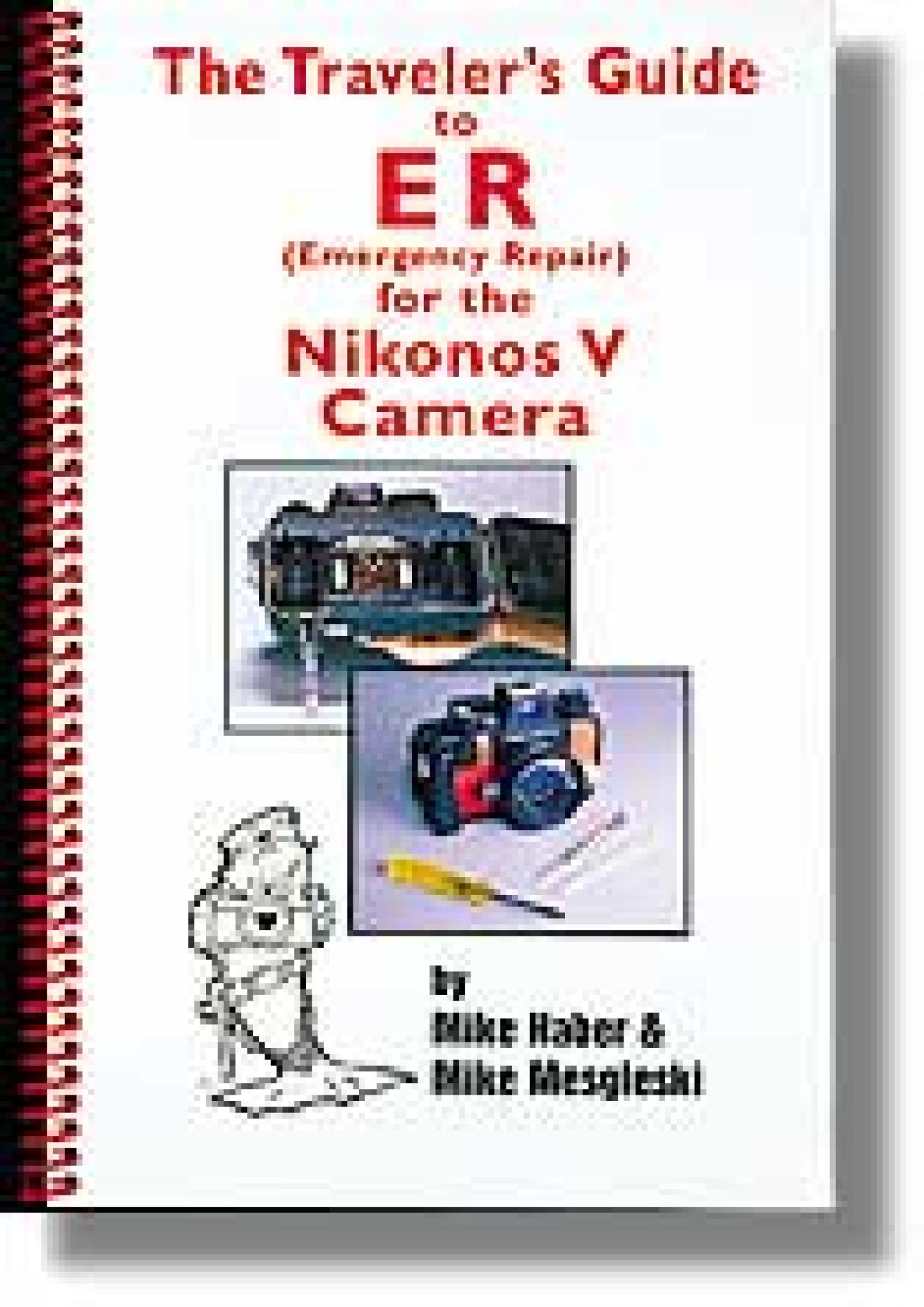
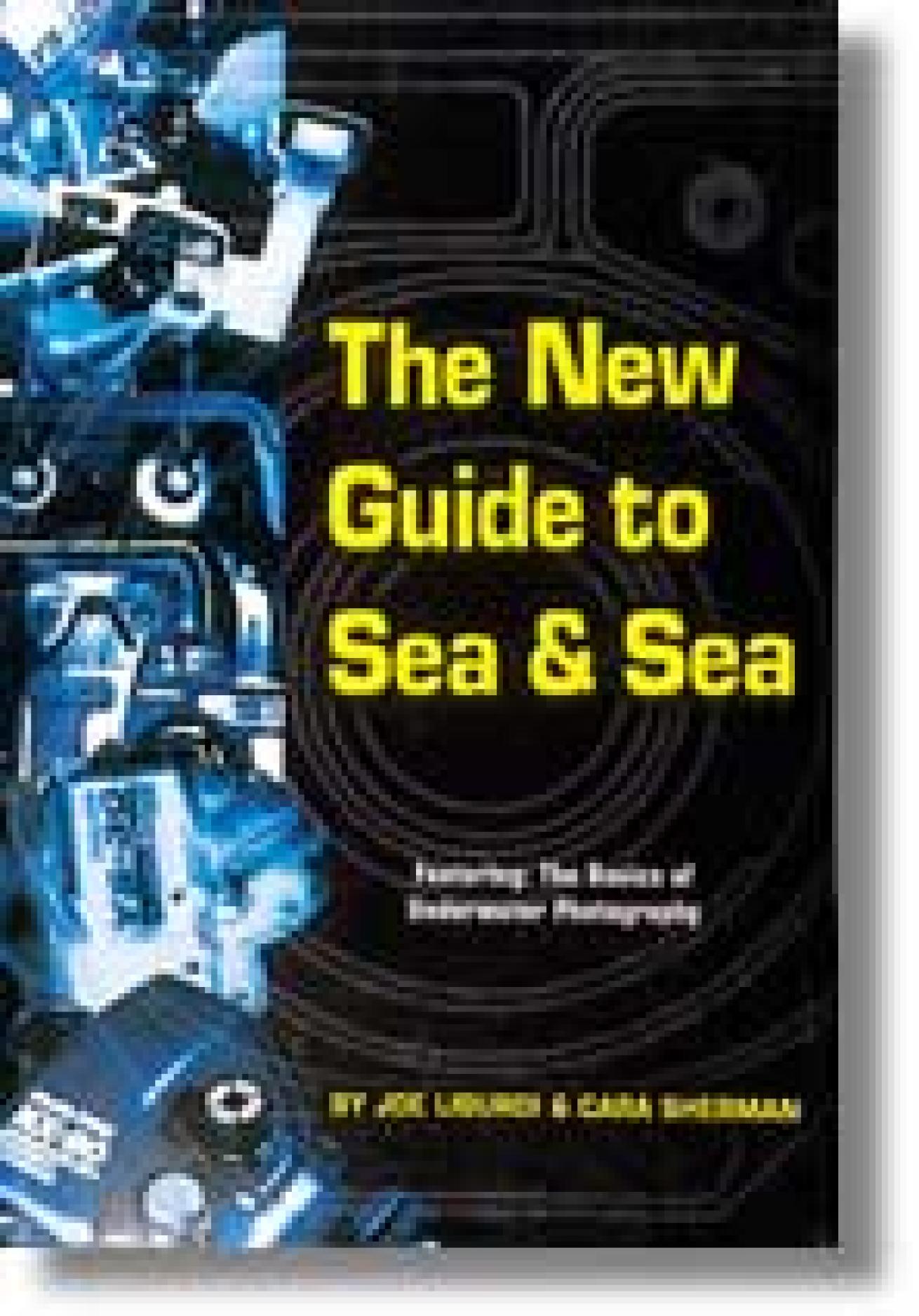
Related Product: Buy "The New Guide to Sea & Sea" now by Mike Haber and Mike Mesgleski, self-published 1998, contact Subtropix Productions at 305-251-1962 or fax 305-251-1962.
There are a massive number of Nikonos V cameras out there, and if my experience is any indication, at some point this camera may flood. Knowing what to do quickly in terms of field repairs makes all the difference between a flooded Nikonos V becoming a mild nuisance or an expensive repair.
This book will help anyone with a modest amount of mechanical aptitude recognize the signs of a flood, and then with simple text and photographic illustrations walk them through disassembly, rinsing, drying and reassembly. If you're thousands of miles from any repair facility and water ends up on the wrong side of your Nikonos V O-ring, you'll be glad to have Haber and Mesgleski in your travel kit.
The New Guide to Sea & Sea
by Joe Liburdi and Cara Sherman, Orca Publications, published 1997, ISBN 0-9621111-3-9
While there are several books to choose from to learn about Nikonos cameras or underwater photography in general, there is only one comprehensive guide dedicated to the ever-expanding Sea & Sea product line. Joe Liburdi and Cara Sherman's collaboration entitled The New Guide to Sea & Sea is a 335-page softcover compendium of charts, illustrations, text and photographs logically organized to present the a wealth of information on both technique and equipment. In addition, more advanced topics like composition, care and maintenance, troubleshooting, traveling and first-aid for floods are covered.
The photos are very well-executed, and chosen to illustrate specific points of text. However, there is a subliminal message as well, for they artfully demonstrate the quality and versatility of the various Sea & Sea systems used. While new Sea & Sea products have been introduced since this book was published, most notably the MX-5 camera and YS-90 and YS-350 strobes, this book is more about the art and science of underwater photography than it is about specific equipment. It is an absolute must for Sea & Sea shooters, but should also be considered a fine reference for any underwater photo enthusiast.
Coral Seas
by Roger Steene, Firefly Books (U.S.), published in 1998, ISBN 1-55209-290-9
Out of 272 pages, there is precious little detailed photographic information in this book. It is only in a few paragraphs on the last page that Roger Steene explains that the photos in the book were taken with a housed 35mm SLR and single flash mounted directly above the camera housing. He allows that his lens arsenal includes a 14mm, 20mm, 24mm, 28-70mm, 60mm macro, 105mm macro, and a few specialty items like a 2X teleconverter for the super-macros and a split diopter for the over/unders. His film of choice is 100 ISO slide film. There's nothing remarkable about the tools, yet there is plenty that is remarkable about the photography, both in terms of how he captured his subjects, and in many cases, how he even saw these creatures.
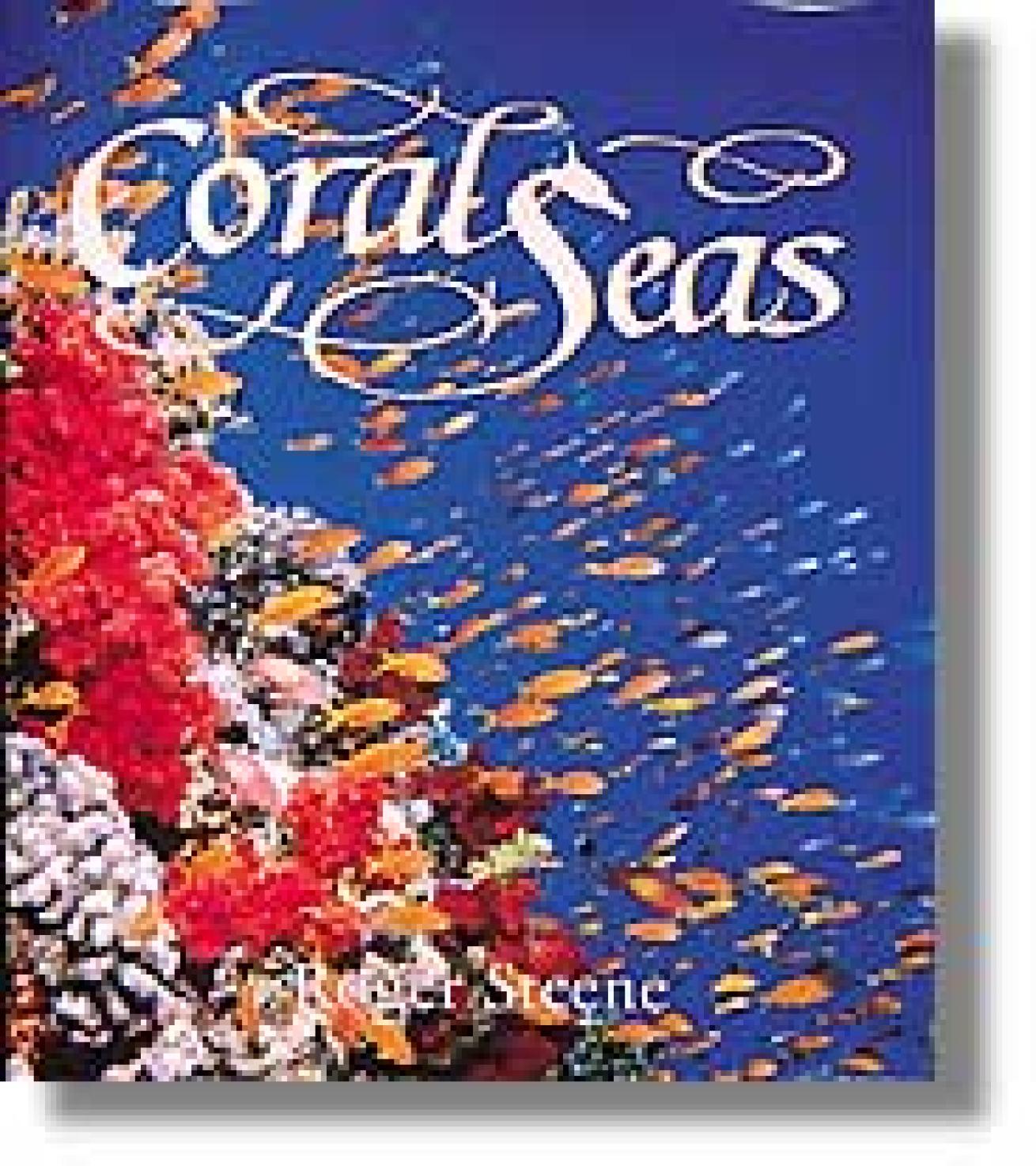
Related Product: Buy "Coral Seas" now| Clearly this book is not about the things underwater photographers so commonly obsess over--things like gear or film or technique. Instead, this book is all about one man's astounding vision, and his ability to document the bizarre beauty and grandeur of Indo-Pacific reefs.
The result of five years of intensive work in places like Indonesia, Papua New Guinea, the Solomon Islands, the Red Sea and the Great Barrier Reef, Steene's photos of the reef's minutiae are among the best ever published. To fully appreciate these images one must experience the boredom of lying motionless along a sand flat waiting for a garden eel to emerge from its burrow. Or struggle with choppy seas while trying to capture an over/under of a shallow coral garden. Or try to pick out a camouflaged pygmy seahorse no larger than a grain of rice from amid a mass of coral polyps. Only then will you realize these photographs are a triumph of patience, talent and countless hours beneath the sea.






